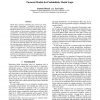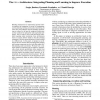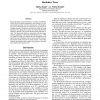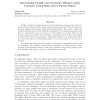AAAI
2008
14 years 2 months ago
2008
Modal logic represents knowledge that agents have about other agents' knowledge. Probabilistic modal logic further captures probabilistic beliefs about probabilistic beliefs....
AAAI
2008
14 years 2 months ago
2008
Building architectures for autonomous rational behavior requires the integration of several AI components, such as planning, learning and execution monitoring. In most cases, the ...
AAAI
2008
14 years 2 months ago
2008
The surprisingly good performance of modern satisfiability (SAT) solvers is usually explained by the existence of a certain "hidden structure" in real-world instances. W...
AAAI
2008
14 years 2 months ago
2008
The Semantic Web language RDF was designed to unambiguously define and use ontologies to encode data and knowledge on the Web. Many people find it difficult, however, to write com...
AAAI
2008
14 years 2 months ago
2008
We develop a point based method for solving finitely nested interactive POMDPs approximately. Analogously to point based value iteration (PBVI) in POMDPs, we maintain a set of bel...
AAAI
2008
14 years 2 months ago
2008
This paper examines, by argument, the dynamics of sequences of behavioural choices made, when non-cooperative restricted-memory agents learn in partially observable stochastic gam...
AAAI
2008
14 years 2 months ago
2008
One of the core goals of the Semantic Web is to store data in distributed locations, and use ontologies and reasoning to aggregate it. Social networking is a large movement on the...
AAAI
2008
14 years 2 months ago
2008
To-do lists have been found to be the most popular personal information management tools, yet there is no automated system to interpret and act upon them when appropriate on behal...
AAAI
2008
14 years 2 months ago
2008
Usually a voting rule requires agents to give their preferences as linear orders. However, in some cases it is impractical for an agent to give a linear order over all the alterna...





